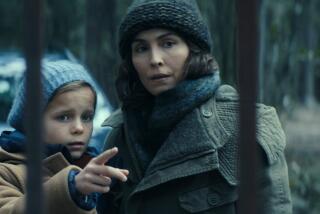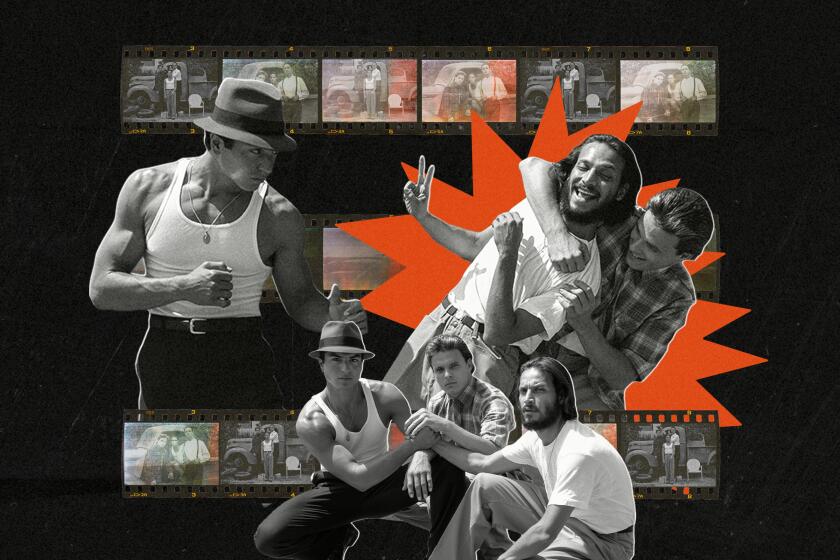Christopher Nolan returns Kubrick sci-fi masterpiece ‘2001: A Space Odyssey’ to its original glory
Christopher Nolan wants to show me something interesting. Something beautiful and exceptional, something that changed his life when he was a boy.
It’s also something that Nolan, one of the most accomplished and successful of contemporary filmmakers, has persuaded Warner Bros. to share with the world both at the upcoming Cannes Film Festival and then in theaters nationwide, but in a way that boldly deviates from standard practice.
For what is being cued up in a small, hidden-away screening room in an unmarked building in Burbank is a brand new 70-mm reel of film of one of the most significant and influential motion pictures ever made, Stanley Kubrick’s 1968 science-fiction epic “2001: A Space Odyssey.”
Yes, you read that right. Not a digital anything, an actual reel of film that was for all intents and purposes identical to the one Nolan saw as a child and Kubrick himself would have looked at when the film was new half a century ago.
How did this come about, how is it even possible? Nolan promises to explain all, but first he wants to show that reel.
Through the door to share the vision come some of the people who made it possible: Ned Price, vice president of restoration at Warner, Vince Roth, technical director at the post-production facility FotoKem, and color timer Kristen Zimmermann.
“When you run a reel of ‘2001,’” Nolan says with a laugh, “everyone wants to watch.” It’s easy to see why.
The reel Nolan has chosen comes early on, showing the wheel-shaped Space Station 5 majestically rotating above Earth impeccably choreographed to the fluid sounds of Johann Strauss’ “The Blue Danube” Waltz, and it’s one of the most familiar in film history.
But seeing the deep colors of the rich, supple images in a 70-mm print made from new elements taken from the original camera negative is frankly breathtaking.
(Moviegoers eager to share this experience do not have long to wait. After its May 13 debut in Cannes, “2001” opens May 18 for limited runs in Los Angeles, New York, Chicago and San Francisco, with Hollywood’s Arclight scheduling virtually round-the-clock screenings starting at 9 a.m.)
“I must have watched that scene 20 times,” the director says when it’s over, clearly affected, “and every time the space station enters the shot, it moves me. The emotional impact this film has is direct more than empathetic: you travel through the Star Gate yourself, you are in there with it.”
“2001” has been one of Nolan’s touchstone films since childhood. “When I was 7 my dad took me to see it at London’s Leicester Square, a very big theater with 70-mm projection,” he recalls. “I remember the scale of it, how larger than life it was. To sit in a theater and be taken on that kind of journey, it’s a screening I’ve carried with me.”
Nolan had been working in this very Burbank room last year, minding his own business and making sure the colors of the 70-mm prints of “Dunkirk” would be matched by the 4K version used for a Blu-ray release, when Kubrick’s film reentered his life.
“Ned Price offered to show me some reels from a print made from the original 70-mm camera negative, and they were amazing,” he recalls. “He told me that in 1999 Warners had made interpositives from the original camera negative, which Vince Roth had very carefully repaired, but they never had the funding to take the next step to make an internegative and strike new prints.”
(An interpositive is a type of film stock that’s essential in going from an original camera negative to a final print.)
Nolan knew that Warner had put more than 100 70-mm projectors into theaters nationwide to show the film version of “Dunkirk,” and that those screenings had been extremely successful.
“I went to Warners and said ‘Let’s start making prints and rerelease this,’” Nolan says. “It won’t be everywhere, more like the old road show releases. A generation of younger people who didn’t get to enjoy film the way we did is hungry for it, they have an appreciation of analog.”
Warner agreed and Nolan’s “Dunkirk” cinematographer Hoyte van Hoytema turned out to be between projects and able to help.
“It felt,” Nolan says, “like the planets were aligning.”
What most excites Nolan about these new “2001” prints is that they are a completely photochemical process, “which is why we chose to call this the unrestored version.”
“The 1999 interpositive had been made with Kubrick’s original notes. None of what we did was interpretive, we didn’t correct mistakes, we didn’t say ‘maybe he would have liked to do it this way.’ We used our technical expertise to make sure we got the best prints possible.”
It’s no secret that Nolan is a passionate believer in shooting and projecting film. But he’s hardly an enemy of digital, seeing it rather as “a tool in the tool kit, not a be all and end all.”
“For restoring films that are horribly damaged, absolutely. For exhibition, it’s very consistent, like McDonald’s, it raises the standards of the worst theaters. But you lose the magnificence of the best possible exhibition.”
When you digitize you clean things up that don’t necessarily bother people, but you lose a tremendous amount of information I call emotional information.
— Christopher Nolan
Nolan considers film to be “still the best analog for the way the eye sees that has ever been produced. Except for the last 10 years, the entire history of cinema has been done exactly the same way, photochemically, and it’s a great passion of mine to maintain this knowledge and expertise, to hang on to that infrastructure.”
“When you digitize you clean things up that don’t necessarily bother people, but you lose a tremendous amount of information I call emotional information.
“There is a natural tendency to mistake sharpness for added information but with the photochemical process you have a direct physical relationship with the original light that came through the lens. The same shadows the filmmaker saw are the ones you watch.”
Nolan and his team worked for four months on “2001,” but he says calling it work doesn’t feel quite right. “It was fun, I consider it a great privilege. I was in the middle of writing a script but whenever I was looking for a reason to mess around I came here.
“The amazing thing about this film is that it sustains multiple viewings. I don’t know if the other movies I love would sustain this level of focus. It’s a radical piece of work, you almost have to go back to D.W. Griffith to find something that new and unprecedented.
“I was a fan going in but this process gave me a much greater appreciation. The film grew stronger and stronger the more I watched it.”
A pause. “That must be the definition of a masterpiece.”
More to Read
Only good movies
Get the Indie Focus newsletter, Mark Olsen's weekly guide to the world of cinema.
You may occasionally receive promotional content from the Los Angeles Times.







